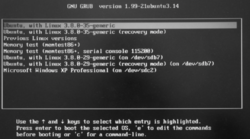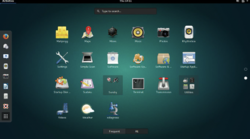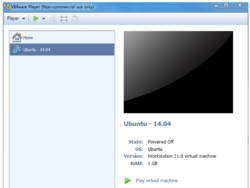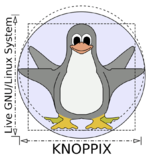Difference between revisions of "Tutorial 7 - Installing Linux / Live Linux / Virtualization"
| Line 1: | Line 1: | ||
| − | + | =INSTALLING LINUX / LIVE LINUX / VIRTUALIZATION= | |
| + | <br> | ||
| + | ===Main Objectives of this Practice Tutorial=== | ||
| + | |||
| + | :* Download and install the '''VirtualBox''' VM software application | ||
| + | |||
| + | :* Download and run the '''Knoppix Live VirtualBox file''' in a virtual machine | ||
| + | |||
| + | :* Open a terminal and connect to your Matrix account via the '''ssh''' utility | ||
| + | |||
| + | :* Run several '''open-source applications''' in your graphical Knoppix Linux environment | ||
| + | |||
| + | :* Understand the '''limitation''' of running Knoppix Live as opposed to a '''persistent''' Knoppix installation | ||
| + | <br> | ||
| + | |||
| + | ===Tutorial Reference Material=== | ||
| + | |||
| + | {|width="100%" cellspacing="0" cellpadding="10" | ||
| + | |||
| + | |- valign="top" | ||
| + | |||
| + | |colspan="2" style="font-size:16px;font-weight:bold;border-bottom: thin solid black;border-spacing:0px;"|Course Notes<br> | ||
| + | |||
| + | |colspan="2" style="font-size:16px;font-weight:bold;border-bottom: thin solid black;border-spacing:0px;padding-left:15px;"|Concepts<br> | ||
| + | |||
| + | |colspan="1" style="font-size:16px;font-weight:bold;border-bottom: thin solid black;border-spacing:0px;padding-left:15px;"|YouTube Videos<br> | ||
| + | |||
| + | |- valign="top" style="padding-left:15px;" | ||
| + | |||
| + | |colspan="2" |Course Notes:<ul><li>[https://matrix.senecacollege.ca/~osl640/slides/OSL640-Week7.pdf PDF] | [https://matrix.senecacollege.ca/~osl640/slides/OSL640-Week7.pptx PPTX]</li></ul> | ||
| + | |||
| + | | style="padding-left:15px;" |Installing Linux | ||
| + | * [https://www.linux.com/training-tutorials/linux-installation-choices/ Linux Installation Choices] | ||
| + | * [https://en.wikipedia.org/wiki/Live_CD Live Linux Definition] | ||
| + | * [https://en.wikipedia.org/wiki/Virtualization Virtualization Definition] | ||
| + | * [https://en.wikipedia.org/wiki/Optical_disc_image ISO Definition] | ||
| + | * [https://en.wikipedia.org/wiki/Virtual_private_network VPN Definition | ||
| + | <br> | ||
| + | Commands | ||
| + | <br> | ||
| + | * [https://man7.org/linux/man-pages/man8/sudo.8.html sudo] | ||
| + | * [https://man7.org/linux/man-pages/man8/ping.8.html ping] | ||
| + | * [https://man7.org/linux/man-pages/man8/dnf.8.html dnf] | ||
| + | | style="padding-left:15px;"|Red Hat Resources | ||
| + | * [https://www.redhat.com/en Red Hat Website] | ||
| + | * [https://access.redhat.com/documentation/en-us/red_hat_enterprise_linux/8/ Red Hat Documentation] | ||
| + | * [https://sso.redhat.com/auth/realms/redhat-external/protocol/openid-connect/registrations?client_id=https%3A%2F%2Fwww.redhat.com%2Fwapps%2Fugc-oidc&redirect_uri=https%3A%2F%2Fwww.redhat.com%2Fwapps%2Fugc%2Fprotected%2Faccount.html&response_type=code&scope=openid Red Hat Registration Page] | ||
| + | |||
| + | |} | ||
| + | |||
| + | = KEY CONCEPTS = | ||
| + | |||
| + | ===Installing Linux=== | ||
| + | |||
| + | |||
| + | Having a Linux system on your home computer provides '''access''' to a large selection of '''open source software'''.<br> | ||
| + | |||
| + | Installing your own version of Linux on your notebook or desktop computer also can make it easier to practice working<br>in the Linux environment and '''learn''' how to perform routine '''Linux OS administration tasks'''. | ||
| + | |||
| + | |||
| + | [[Image:distro-1.png|thumb|right|450px|Listing of Common Linux Distributions.<br>(Image licensed under [https://creativecommons.org/licenses/by-sa/3.0/ cc])]] | ||
| + | ''A '''Linux distribution''' (often abbreviated as distro) is an operating system made from a software collection that is based upon the Linux kernel and, often, a package management system. Linux users usually obtain their operating system by downloading one of the Linux distributions, which are available for a wide variety of systems...'' | ||
| + | |||
| + | Reference: https://en.wikipedia.org/wiki/Linux_distribution | ||
| + | |||
| + | |||
| + | ''Steps in the Linux Installation Process:'' | ||
| + | |||
| + | * '''Select''' a ''Linux Distribution'' to '''download''' (ISO image file or VM file). | ||
| + | * '''Create''' VM and '''install''' Linux Distribution or '''run''' VM file. | ||
| + | <br> | ||
| + | |||
| + | ===Linux Installation Methods=== | ||
| + | [[Image:stand-alone.png|thumb|right|250px|Linux is the only OS on the computer<br>(Image licensed under [https://creativecommons.org/licenses/by-sa/3.0/ cc])]] | ||
| + | |||
| + | '''Standalone Installation''' | ||
| + | |||
| + | : Linux is the <u>only</u> OS on the computer. | ||
| + | : Any existing data on your hard disk will be '''erased'''. | ||
| + | |||
| + | |||
| + | [[Image:grub-boot-menu.png|thumb|right|250px|The '''grub boot menu''' to select different operating systems upon computer startup.<br>(Image licensed under [https://creativecommons.org/licenses/by-sa/3.0/ cc])]] | ||
| + | '''Dual-boot / Multi-boot Installation''' | ||
| + | |||
| + | : A '''boot menu''' allows the user to select the desired OS.<br><br> | ||
| + | : '''Advantages''' of Dual-Boot or Multi-Boot:<ol><li>This option provides a method to access your computer if one OS '''fails to boot-up'''.</li><li>'''Access the Windows partition''' if your Windows OS cannot boot-up.</li><li>This booting method is great for '''troubleshooting'''<br>(''for example:'' boot into Linux OS to eliminate a hardware issue).</li></ol> | ||
| + | : '''Installation Tips:'''<ol><li>It is recommended to '''back up important data''' before proceeding.</li><li>It is recommended to '''install the Linux OS <u>last</u>''', as other operating systems may not offer a multi-boot option.</li></ol> | ||
| + | |||
| + | |||
| + | '''Virtual Machine Installation''' | ||
| + | |||
| + | [[Image:vm-player-menu.png|thumb|right|250px|VMware Player launch menu for Ubuntu Linux OS<br>(Image licensed under [https://creativecommons.org/licenses/by-sa/3.0/ cc])]] | ||
| + | : ''Virtualization is the process of running a virtual instance of a computer system in a layer abstracted from the actual hardware.'' Reference: https://opensource.com/resources/virtualization | ||
| + | : The virtualized OS is installed and run in a window under another OS. Special software is used to manage the entire process, referred to as the '''hypervisor'''.<br><br> | ||
| + | : '''Advantages''' of Virtualization:<ol><li>You can run VM from an '''ISO image file''' or a '''VM file'''.</li><li>One or more virtual machines can be run at the <u>same</u> time.</li><li>The '''guest''' OS '''shares hardware''' with the '''host''' OS and possibly other virtualized systems.</li><li>The '''guest''' systems have '''network access''' through the host.</li></ol> | ||
| + | : '''Installation Tips:'''<ol><li>Virtualization requires a '''compatible processor''': not all processors support that feature.</li><li>Your '''BIOS''' should be set to '''<u>enable</u> Virtualization'''.</li><li>Popular VM software for '''Windows''', '''Apple''' and '''Linux''' OS include:<ul><li>VMware</li><li>Oracle Virtual Box</li></ul></li></ol> | ||
| + | |||
| + | <br> | ||
| + | |||
| + | ===Live Linux CD=== | ||
| + | |||
| + | [[Image:linux-distro-2.png|thumb|right|150px|Knoppix is a popular Live Linux CD Distribution.<br>(Image licensed under[https://creativecommons.org/licenses/by-sa/3.0/ cc])]] | ||
| + | ''A live CD (also live DVD, live disc, or live operating system) is a complete bootable computer installation including operating system which runs directly from a CD-ROM or similar storage device into a computer's memory, rather than loading from a hard disk drive. A Live CD allows users to run an operating system for any purpose without installing it or making any changes to the computer's configuration. '' | ||
| + | |||
| + | Reference: https://en.wikipedia.org/wiki/Live_CD | ||
| + | |||
| + | |||
| + | The '''Knoppix Live CD''' is available to run on workstations at Seneca College via '''AppsAnywhere'''<br>or you can download and run it on your home computer as a Virtual Machine<br>(requires '''VirtualBox''' VM software installed on your computer).<br><br> | ||
| + | <!-- | ||
| + | :''Steps to Run Knoppix from AppsAnywhere (Seneca Labs):'' | ||
| + | <table align="right"><tr valign="top" ><td>[[Image:knoppix-3.png|thumb|right|280px|'''Launch Knoppix''' from '''Virtualbox''' menu.<br>(Image licensed under[https://creativecommons.org/licenses/by-sa/3.0/ cc])]]</td><td>[[Image:knoppix-4.png|thumb|right|200px|Click '''Switch''' to enter '''scale mode'''.]]</td></tr></table> | ||
| + | #Start your Seneca College lab workstation and login to your Seneca Windows account. | ||
| + | #Click on the '''Search Apps''' area located in the top right corner of the MyApps window and type the word: '''knoppix''' | ||
| + | #Select the ''knoppix'' application icon and click '''Launch'''. Your file manager will open and display both the Knoppix virtual machine icon and a Knoppix Installation ISO file. | ||
| + | # '''Double-click''' on the icon '''Knoppix.vbox''' The Virtualbox application will launch and display the virtual machine for Knoppix. | ||
| + | # '''Double-click''' on the Knoppix VM in the left window to launch this VM and click the '''Switch''' button when prompted to enter scale mode. | ||
| + | |||
| + | :''Steps to Run Knoppix Live from Your Remote Computer:'' | ||
| + | [[Image:knoppix-download.png|thumb|right|280px|'''Knoppix Download Webpage.]] | ||
| + | # Click on the following link to download the lastest knoppix ISO:<br>[https://www.knopper.net/knoppix-mirrors/index-en.html https://www.knopper.net/knoppix-mirrors/index-en.html]<br><br> | ||
| + | # If you are burning to a CD, click on the following link for instructions:<br>[https://www.wikihow.com/Install-Knoppix-Linux Install Knoppix LInux]<br><br>'''NOTE:''' If you are burning to a USB, click on the following link for instructions:<br>[https://itstillworks.com/boot-knoppix-usb-6904288.html How to Boot Knoppix from USB] --> | ||
| + | <br><br> | ||
= INVESTIGATION 1: CREATING A RED HAT ACCOUNT AND DOWNLOADING THE ISO = | = INVESTIGATION 1: CREATING A RED HAT ACCOUNT AND DOWNLOADING THE ISO = | ||
Revision as of 15:11, 12 September 2021
Contents
- 1 INSTALLING LINUX / LIVE LINUX / VIRTUALIZATION
- 2 KEY CONCEPTS
- 3 INVESTIGATION 1: CREATING A RED HAT ACCOUNT AND DOWNLOADING THE ISO
- 4 INVESTIGATION 2: CREATING A VIRTUAL MACHINE IN VMWARE AND INSTALLING RED HAT ENTERPRISE LINUX
- 5 INVESTIGATION 3: INSTALLING THE GLOBAL PROTECT VPN AND CONNECTING TO MATRIX FROM YOUR VIRTUAL MACHINE
- 6 LINUX PRACTICE QUESTIONS
INSTALLING LINUX / LIVE LINUX / VIRTUALIZATION
Main Objectives of this Practice Tutorial
- Download and install the VirtualBox VM software application
- Download and run the Knoppix Live VirtualBox file in a virtual machine
- Open a terminal and connect to your Matrix account via the ssh utility
- Run several open-source applications in your graphical Knoppix Linux environment
- Understand the limitation of running Knoppix Live as opposed to a persistent Knoppix installation
Tutorial Reference Material
| Course Notes |
Concepts |
YouTube Videos | ||
| Course Notes: | Installing Linux
|
Red Hat Resources | ||
KEY CONCEPTS
Installing Linux
Having a Linux system on your home computer provides access to a large selection of open source software.
Installing your own version of Linux on your notebook or desktop computer also can make it easier to practice working
in the Linux environment and learn how to perform routine Linux OS administration tasks.
A Linux distribution (often abbreviated as distro) is an operating system made from a software collection that is based upon the Linux kernel and, often, a package management system. Linux users usually obtain their operating system by downloading one of the Linux distributions, which are available for a wide variety of systems...
Reference: https://en.wikipedia.org/wiki/Linux_distribution
Steps in the Linux Installation Process:
- Select a Linux Distribution to download (ISO image file or VM file).
- Create VM and install Linux Distribution or run VM file.
Linux Installation Methods
Standalone Installation
- Linux is the only OS on the computer.
- Any existing data on your hard disk will be erased.

(Image licensed under cc)
Dual-boot / Multi-boot Installation
- A boot menu allows the user to select the desired OS.
- Advantages of Dual-Boot or Multi-Boot:
- This option provides a method to access your computer if one OS fails to boot-up.
- Access the Windows partition if your Windows OS cannot boot-up.
- This booting method is great for troubleshooting
(for example: boot into Linux OS to eliminate a hardware issue).
- Installation Tips:
- It is recommended to back up important data before proceeding.
- It is recommended to install the Linux OS last, as other operating systems may not offer a multi-boot option.
Virtual Machine Installation
- Virtualization is the process of running a virtual instance of a computer system in a layer abstracted from the actual hardware. Reference: https://opensource.com/resources/virtualization
- The virtualized OS is installed and run in a window under another OS. Special software is used to manage the entire process, referred to as the hypervisor.
- Advantages of Virtualization:
- You can run VM from an ISO image file or a VM file.
- One or more virtual machines can be run at the same time.
- The guest OS shares hardware with the host OS and possibly other virtualized systems.
- The guest systems have network access through the host.
- Installation Tips:
- Virtualization requires a compatible processor: not all processors support that feature.
- Your BIOS should be set to enable Virtualization.
- Popular VM software for Windows, Apple and Linux OS include:
- VMware
- Oracle Virtual Box
Live Linux CD
A live CD (also live DVD, live disc, or live operating system) is a complete bootable computer installation including operating system which runs directly from a CD-ROM or similar storage device into a computer's memory, rather than loading from a hard disk drive. A Live CD allows users to run an operating system for any purpose without installing it or making any changes to the computer's configuration.
Reference: https://en.wikipedia.org/wiki/Live_CD
The Knoppix Live CD is available to run on workstations at Seneca College via AppsAnywhere
or you can download and run it on your home computer as a Virtual Machine
(requires VirtualBox VM software installed on your computer).



